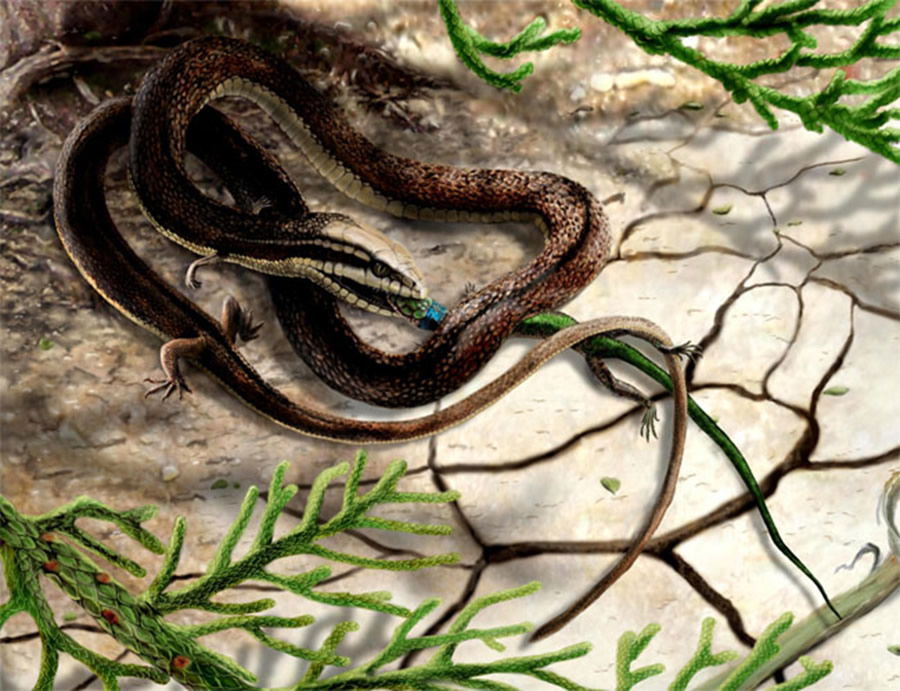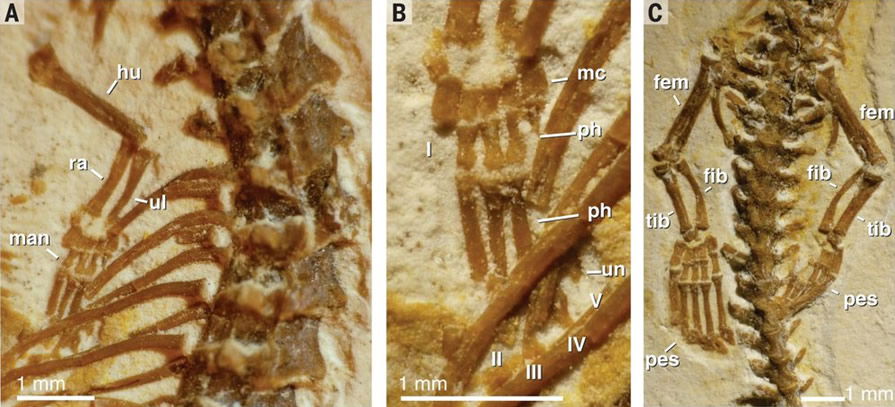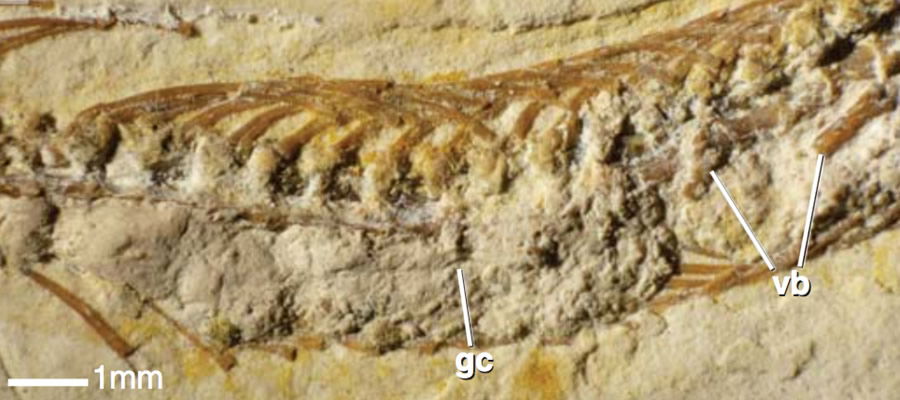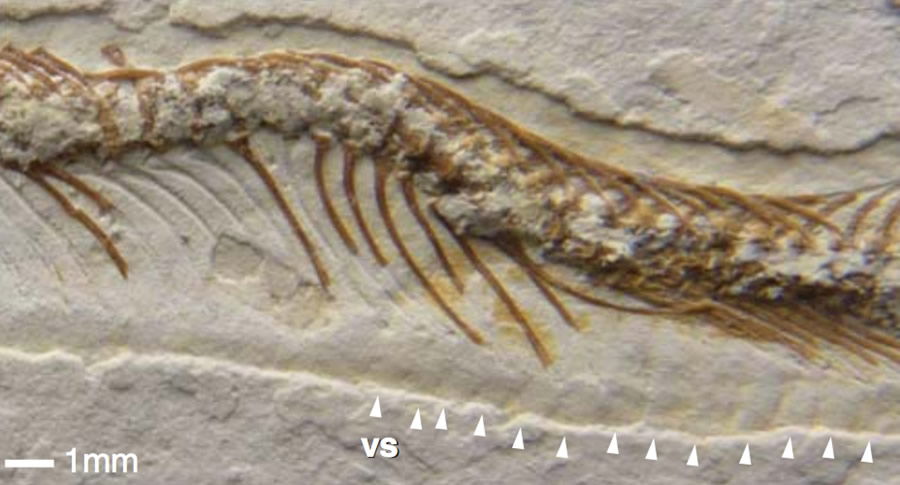
Four-Legged Snake Fossil Found in Museum
News to Know
News Sources
- Nature: “Four-Legged Fossil Snake Is a World First”
- ScienceDaily: “Four-Legged Snake Fossil Found”
Living snakes lack legs.1 Many evolutionists believe the recent discovery of a four-legged fossilized snake is evidence of a burrowing lizard in the snake’s evolutionary past. But is there another explanation? An explanation consistent with observable biological science and the Word of God?
A Day at the Museum
The four short legs on the 20 cm (7.8 in) snake-like fossil from Brazil’s Crato formation remained unnoticed in Germany’s Museum Solnhofen until spotted by University of Portsmouth paleontologist David Martill during a field trip. “The fossil was part of a larger exhibition of fossils from the Cretaceous period,” Martill says. “It was clear that no-one had appreciated its importance, but when I saw it I knew it was an incredibly significant specimen.”2
Martill recruited Helmut Tischlinger and Nicholas Longrich to help study the fossil. “The preservation of the little snake is absolutely exquisite,” Tischlinger says. “The skeleton is fully articulated. Details of the bones are clearly visible and impressions of soft tissues such as scales and the trachea are preserved.” Longrich adds, “It is a perfect little snake, except it has these little arms and legs, and they have these strange long fingers and toes.”3
Their photographs and description recently appeared in Science. So did their evolutionary conclusions.

This is a photograph of Tetrapodophis, an unusual four-limbed fossilized snake from Lower Cretaceous rock in Brazil’s Crato formation. Like many fossils from that location, this 20-cm-long skeleton is articulated, and soft tissues are preserved. Image reproduce from D. Martill et al., “A Four-Legged Snake from the Early Cretaceous of Gondwana,” Science 349, no. 6246 (July 24, 2015): 416–419, doi:10.1126/science.aaa9208.

This artist’s representation of Tetrapodophis features the fossil’s most un-snakelike features: four tiny limbs. It is depicted eating a vertebrate because the animal had vertebrate remains in its gut. Image reproduced from James Brown, University of Portsmouth, via National Geographic.
These Feet Weren’t Made for Walking

These photos show Tetrapodophis’s limbs. In the forelimb (A) the humerus (hu), radius (ra), ulna (ul) and hand (man) are easily seen, and in the close-up of a hand (or manus, shown in B) the metacarpals (mc) and phalanges (ph) are seen and numbered. Both hindlimbs and the pelvis are shown in (C) with the femurs (fem), tibias (tib), fibulas (fib) and feet (pes) labeled. Each fibula is bowed like that in Najash, the two-legged snake fossil discovered in Cretaceous rock Patagonia in 2006.4 The design of the limbs would have likely made them useful for grasping, but the size of the limbs as well as the limitations posed by the rest of the snake’s elongated axial skeleton would have made walking impossible. Image reproduced from D. Martill et al., “A Four-Legged Snake . . . ” doi: 10.1126/science.aaa9208.
As shown in these published photographs, the bone structure of the limbs is familiar, matching the design common to vertebrate limbs. “The front legs are very small, about 1cm long, but have little elbows and wrists and hands that are just 5mm in length,” according to a University of Portsmouth press release. “The back legs are slightly longer and the feet are larger than the hands and could have been used to grasp its prey.”5 However, the researchers do not suggest that the animal used its tiny legs for walking, except for marching up (or down, depending on how you look at it) the evolutionary tree of life.
“They are very, very small, and did not perform as walking legs,”6 Martill says. “The hands and feet are very specialized for grasping,” Longrich explains. That’s why the team named it Tetrapodophis amplecta, meaning “four-legged hugging snake.” Embracing a terrestrial evolutionary saga involving limbs “repurposed for another function,”7 Longrich explains, “So when snakes stopped walking and started slithering, the legs didn't just become useless little vestiges—they started using them for something else. We're not entirely sure what that would be, but they may have been used for grasping prey, or perhaps mates.”8
While other legged snake fossils have been found, Martill’s team writes, “As the only known four-legged snake, Tetrapodophis sheds light on the evolution of snakes from lizards.”9 They believe this even though its assigned age of 110 million years would make Tetrapodophis far younger than the oldest dated legless snakes—the 143–167-million-year-old snakes identified by University of Alberta paleontologist Michael Caldwell earlier this year.10
Is It a Snake?
The team reports that Tetrapodophis has several anatomical features unique to snakes as well as a combination of features found only in snakes.11
Snakes typically have over 150 vertebrae with elongated bodies and shorter tails. One hundred sixty of Tetrapodophis’s 272 vertebrae are pre-caudal (above the tail). Its broad-based hooked teeth as well as the way these teeth are implanted above horizontally oriented replacements are snake-specific traits.12 Like modern snakes Tetrapodophis had an intramandibular joint enabling its expansive jaw to engulf prey, an ability attested to by the vertebrate remains in its gut.

The remains of a vertebrate were found in the fossil’s gut. (gc=gut contents; vb=vertebrate bones) Image reproduced from D. Martill et al., “A Four-Legged Snake . . . ” doi: 10.1126/science.aaa9208.
Furthermore, the row of broad transverse scales on the fossil’s belly is unique to snakes. Tetrapodophis “has a single row of belly scales, it has very snake-like vertebrae, it has a body longer than the tail, it has hundreds of vertebrae, it has the remains of other vertebrate animals in the stomach and so it was a carnivore, it has backward pointing teeth,” Martill says. “All these things make it a snake.”13

This photograph of Tetrapodophis shows scales (vs) preserved along its ventral surface. These scales are typical of the scales found on a snake’s belly. Image reproduced from D. Martill et al., “A Four-Legged Snake . . . ” doi:10.1126/science.aaa9208.
Some suggest Tetrapodophis was not a snake at all. For instance, Caldwell—himself an authority on snake morphology—disagrees with Martill’s conclusions regarding the snake-likeness of the fossil’s vertebrae. Caldwell also seems to doubt that animal is even a squamate, the order of scaled reptiles that includes snakes, lizards, and worm lizards. He says, “I honestly do not think the fossil represents the remains of a snake,” explaining “it completely lacks key features of the vertebral column that would make it a squamate and more specifically a snake.”14 Admitting its teeth look like a snake’s, he nevertheless says, “If the rest of the animal is not a squamate, then teeth do not make you a snake,” and adds, “I think the specimen is important, but I do not know what it is.”15
Others, like paleontologist Jean-Claude Rage of the Natural History Museum of Paris, acknowledge these objections but still consider the fossil a bona fide snake. Rage explains that the row of large, elongated scales along the belly “may be quite significant; it may be a ‘signature’ of snakes.” And Jacques Gauthier of Yale University’s Peabody Museum of Natural History agrees, “Looks like a snake to me. The long body and reduced limbs, along with the bony supports in the pelvis for lymph hearts to pump blood back to the heart, are consistent with being a snake.”16
Evolutionary Options
Evolutionists have long debated whether snakes evolved from legged lizards or legless marine reptiles. (They of course do not seriously consider the claim that God created them.) The researchers are convinced Tetrapodophis represents an evolutionary transition confirming a terrestrial lineage. “Tetrapodophis doesn’t show any aquatic adaptations—no long, oar-like tail, no thick bones to act as ballast, no flippers. But it does show some pretty classic burrowing features, like low spines on the vertebrae, and a short tail and a long trunk,” Longrich explains.17 “It is generally accepted that snakes evolved from lizards at some point in the distant past,” Martill adds. “What scientists don’t know yet is when they evolved, why they evolved, and what type of lizard they evolved from. This fossil answers some very important questions, for example it now seems clear to us that snakes evolved from burrowing lizards, not from marine lizards.”18
But does it demonstrate that? Not at all. First of all, loss of a function (like walking) or an anatomical feature (like legs) is not evidence of evolution.19 In fact, loss of information due to mutations and other genetic events happens often in this cursed world. Lizards and snakes share many features, but you can’t just subtract legs from a lizard and get a snake. Snakes differ from lizards in far more than their lack of legs. These differences cannot be accounted for through loss of information in the snake-ward direction. (You can read about the unique anatomical features that distinguish snakes20 from other kinds of animals in “An Initial Estimate toward Identifying and Numbering Extant Tuatara, Amphisbaena, and Snake Kinds.”)
Biological science has failed to show any way that one kind of animal can obtain the information to evolve into a new, different kind of animal, as lizard-to-snake evolution would require. Snakes are not just lizards minus the legs. For instance, snakes have many more vertebrae and each neck and trunk vertebra has an attached rib; the construction of the back of the snake skull and certain features of the snake circulatory and neurological anatomy are unique; the snake’s intramandibular joint allows the right and left parts of the jaw to separate.21 Thus, biologically speaking we should not view snakes as specialized descendants or evolutionary progeny of lizards. Nothing about Tetrapodophis demonstrates lizard-to-snake evolution but only that some leggy snakes once slithered on this earth.
A Checkered Past
After Adam and Eve sinned, God cursed the serpent to move on its belly (Genesis 3:14), a memorial to the serpent’s role when Satan tricked Eve to disobey God. Many Bible-believing scholars believe Scripture indicates God made a change in the snake’s body plan. Though we cannot be dogmatic about the nature of a pre-Fall animal, perhaps God “switched off” certain genes in serpents. (Read more about it in “Did the Serpent Originally Have Legs?,” “Left in the Dust,” “What About the Snake in the Garden of Eden?,” and “The Devil Is in the Details . . . or Is He?”)
No one, however, should get the idea that this four-legged snake is an escapee from the Garden of Eden! For one thing, animals catastrophically buried in Cretaceous sediment were buried during the global Flood about 1,700 years after creation. For another, Tetrapodophis was as belly-bound as legless snakes. Extinct leggy snakes could conceivably be varieties resulting from mutations affecting genes switched off in the wake of God’s curse upon the serpent. Alternatively, the biodiversity evident in unusual snakes or snake-like reptiles could simply be a testimony to the creativity of our Creator.

Snakes are not the only animals to have existed in both legged and legless varieties. This is a Mexican worm lizard, Bipes biporus. Though most worm lizards are legless, some worm lizards (like this one) have legs. Worm lizards are not snakes, and like true lizards differ from snakes anatomically in some essential points. Read more about them in “Oceanic Dispersal Rafted Worm Lizards Around the World.” Image reproduced from user “marlin harms,” Wikimedia Commons.
Two Snakes, Two Messages
The first serpent to really get mankind’s attention was the serpent whose body was co-opted by Satan, encouraging Eve to doubt God’s Word by asking, “Has God indeed said . . . ?
” (Genesis 3:1). Now, 6,000 years later, several things about this four-legged fossilized snake (assuming it is a snake . . . still an open question among snake experts) can remind us that when God says something, He does it!
First of all, even with four limbs Tetrapodophis was bound to move about on its belly as God said serpents henceforth would (Genesis 3:14). Secondly, like all living snakes, Tetrapodophis’s carnivorous diet attests to the deadly consequences of rebellion against God. Among the sad changes that Adam’s sin brought to the good world (Genesis 1:31) God made was death, not only for mankind (Genesis 2:17), but also for animals. Many eventually became carnivorous, including this snake buried about 4,350 years ago during the Flood. (Read more about these changes in “How Did Defense/Attack Structures Come About?” and “Evolution of Snake Venom: A New Use for Old Genes?”)
Finally, the exquisite preservation of Tetrapodophis’s bones and soft tissues attest to its sudden burial during the global Flood by which God said He would judge the world for man’s overwhelmingly sinful thoughts and ways (Genesis 6:5–8). Indeed all people are sinners (Romans 3:23) deserving of death (Romans 6:23). But God also said repeatedly that He would provide a way of salvation. We see that salvation pictured in God’s sacrifice of an animal to clothe Adam and Eve in Genesis 3, and we learn throughout God’s Word that God says eternal salvation is available through repentance and trust in the sacrificial substitutionary death and resurrection of God’s Son Jesus Christ (John 3:16, 5:24).
Long ago Satan used a serpent to tell Eve to doubt God’s Word. Today Tetrapodophis should remind us to take God at His Word. If we are wise, we will reject the deceptive interpretation evolutionists impose upon this fossil and all their God-rejecting implications. God did not use molecules-to-man evolution to create life over millions of years but spoke all kinds of animals and man into existence during Creation Week. Let the rocks in which this snake was preserved cry out (Luke 19:40) to all who will listen (Mark 4:23) a message of trust in God’s Word from the first Adam in Genesis to the Last Adam (1 Corinthians 15:45), Jesus Christ, our Creator (John 1:1–3; Colossians 1:16–17) and our only Savior (1 Timothy 2:5).
Further Reading:
- A Snake Version of Lucy
- Evolution of Snakes on the Fast Track
- Mamba Venom Derives from Gene Duplication
- Evolution of Snake Venom: A New Use for Old Genes?
- Did Snakes Shape Our Brains?
- An Initial Estimate toward Identifying and Numbering Extant Tuatara, Amphisbaena, and Snake Kinds
- Did the Serpent Originally Have Legs?
- Left in the Dust
- The Devil Is in the Details . . . or Is He?
- What About the Snake in the Garden of Eden?
- Fruit-Eating Crocodiles Dispel Carnivorous Misconceptions
For More Information: Get Answers
Remember, if you see a news story that might merit some attention, let us know about it! (Note: if the story originates from the Associated Press, FOX News, MSNBC, the New York Times, or another major national media outlet, we will most likely have already heard about it.) And thanks to all of our readers who have submitted great news tips to us. If you didn’t catch all the latest News to Know, why not take a look to see what you’ve missed?
(Please note that links will take you directly to the source. Answers in Genesis is not responsible for content on the websites to which we refer. For more information, please see our Privacy Policy.)
Footnotes
- Some have tiny appendage-like structures useful as they mate, but snakes simply don’t walk around on legs.
- University of Portsmouth, “Four-Legged Snake Fossil Found,” ScienceDaily, July 23, 2015, http://www.sciencedaily.com/releases/2015/07/150723140142.htm.
- Ibid.
- Sebastián Apesteguía and Hussam Zaher, “A Cretaceous Terrestrial Snake with Robust Hindlimbs and a Sacrum,” Nature 440 (April 20, 2006): 1037-1040, doi:10.1038/nature04413.
- “Four-Legged Snake Fossil Found,” University of Portsmouth News, July 23, 2015, http://www.port.ac.uk/uopnews/2015/07/23/four-legged-snake-fossil-found/.
- “Four-Legged Fossil Holds Secret of Snake’s Slithering Origins,” New Scientist, July 29, 2015, https://www.newscientist.com/article/dn27949-four-legged-fossil-holds-secret-of-snakes-slithering-origins/.
- D. Martill et al., “A Four-Legged Snake . . . ” doi: 10.1126/science.aaa9208.
- University of Portsmouth, “Four-Legged Snake Fossil Found.”
- D. Martill et al., “A Four-Legged Snake . . . ” doi: 10.1126/science.aaa9208.
- M. Caldwell et al., “The Oldest Known Snakes from the Middle Jurassic-Lower Cretaceous Provide Insights on Snake Evolution,” Nature Communications 6, no. 5996 (January 27, 2015), doi:10.1038/ncomms6996.
- D. Martill et al., “A Four-Legged Snake . . . ” doi: 10.1126/science.aaa9208.
- Ibid.
- “Four-Legged Fossil Holds Secret . . . ” New Scientist.
- Science magazine notes, “In particular, the front surfaces of the vertebrae of known snakes and lizards except geckoes are concave, and the rear surfaces are convex; that doesn’t appear to be the case in Tetrapodophis, he [Caldwell] says.” From Sid Perkins, “Four-Legged Snake Fossil Stuns Scientists—and Ignites Controversy,” July 23, 2015, http://www.sciencemag.org/news/2015/07/four-legged-snake-fossil-stuns-scientists-and-ignites-controversy.
- “Four-Legged Fossil Holds Secret . . . ” New Scientist.
- Ibid.
- Ibid.
- “Four-Legged Snake Fossil Found,” University of Portsmouth News.
- Upward evolution would require the acquisition of information to develop into a different, more complex kind of organism.
-
As Tom Hennigan explains in his Answers Research Journal article describing the various kind of snakes, there are a number of features that are unique to snakes, demonstrating that snakes—whether they have legs or not—are not some kind of lizard. Some, though not all, of these traits are preserved in the snake-like four-legged fossil Tetrapodophis. Hennigan writes,
Though they [snakes] share many traits with other squamates, there are a few traits unique to them [snakes] and they include: pectoral girdle and forelimbs absent but some may have a “rudimentary” pelvic girdle or hindlimbs in the form of a bony spur, 120 to 500 vertebrae, each neck and trunk vertebra has a pair of ribs making them extremely flexible, in the cranium the supraoccipital is excluded from the margin of the foramen magnum by exoccipitals, flexible ligamentous symphysis between the dentaries allows the right and left jaw to widely spread apart, left lung absent or largely reduced, dominant right lung, ophthalmic branch of the trigeminal nerve is enclosed within the brain case and enters the orbit through the optic foramen (in other squamates the nerve is not enclosed and enters the orbit posteriorly), the left arterial arch is larger than the right (in all other tetrapods it is the reverse), and the absence of ciliary-body muscles in the eye.
From “An Initial Estimate toward Identifying and Numbering Extant Tuatara, Amphisbaena, and Snake Kinds,” Answers Research Journal 7 (2014): 31–47, https://answersingenesis.org/creation-science/baraminology/an-initial-estimate-toward-identifying-and-numbering-extant-tuatara-amphisbaena-and-snake-kinds/.
- Read more about it in Hennigan, “An Initial Estimate toward Identifying . . ..”
Recommended Resources

Answers in Genesis is an apologetics ministry, dedicated to helping Christians defend their faith and proclaim the good news of Jesus Christ.
- Customer Service 800.778.3390
- © 2024 Answers in Genesis


